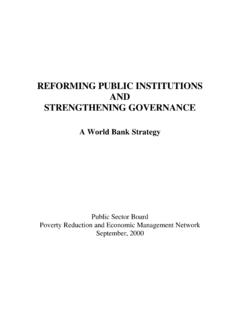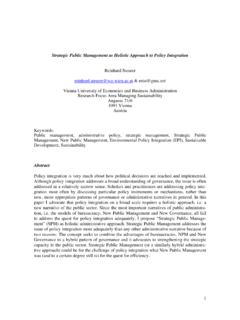Transcription of Organizing Prisons through Public-Private …
1 Available online at Organizing Prisons through Public-Private Partnerships: a Cross-Country Investigation Sandro Cabral * E-mail address: Universidade Federal da Bahia EA/UFBA Salvador, BA, Brazil. St phane Saussier E-mail address: Universit Paris 1 Panth on-Sorbonne Paris, France. * Corresponding author: Sandro Cabral Av. Reitor Miguel Calmon, s/n, , Salvador, BA, 40110-903, Brazil. Received 27 January 2012; received in revised form 12 June 2012; accepted 2 September 2012. S. Cabral, S. Saussier Abstract In this paper, we analyze the private participation in prison services in three countries: Brazil, France, and the United States.
2 We highlight striking differences in efficiency between these countries and argue that the explanation for these differences is not restricted to the way property rights are distributed ( public vs. private management). Instead, our analysis suggests that understanding those differences also requires an analysis of the incentives provided by contractual choices as well as decision and revenue rights distribution and institutional constraints. The theoretical literature usually analyzes these blocks separately, and often focuses on property rights distribution. We argue that an efficient arrangement is the result of the way these elements are combined, giving rise to a distinctive governance structure.
3 Key words: Public-Private partnerships; contractual choices; private Prisons . Organizing Prisons through Public-Private Partnerships Introduction In the last twenty years, several governments throughout the world have introduced reforms as a means to leverage investments in public services through the private sector (Estache, 2006). The water (Chong, Huet, Saussier, & Steiner, 2006), electricity (Glachant & Finon, 2003), roads (Athias & Saussier, 2007), telecommunications (Levy & Spiller, 1994) and also even more human and less-infrastructure sectors such as health care (Albreht & Klazinga, 2009) and social security (Cronqvist & Thaler, 2004) have been analyzed.
4 However, little is known about the public and private governance of criminal justice services, such as Prisons (Cabral & Azevedo, 2008). Researchers seldom focus their studies on the correctional sector, probably because the process of obtaining relevant information is not an easy task: non-consolidated data and confidentiality are factors that often disturb and frequently impede the execution of research in this sector (Dilulio, 1996). Because of this, the issues related to prison performance remain a kind of black-box when compared to other public service utilities. Notwithstanding, Prisons are often used as an example to illustrate theoretical models concerned with the proper scope of government (Bennett & Iossa, 2006; Hart, 2003; Hart, Shleifer, & Vishny, 1997).
5 This type of public service implies several tasks that can be split between public and private authorities and that may differ depending on the kind of prisoners. In addition, the management of prison services is quite complex due to the diversity of such tasks. In fact, in order to prevent escapes, riots, and so on, prison managers must provide prisoners with food as well as healthcare, judicial and reentry services, all of which require the coordination of different institutions and organizations. Of course, this interaction is not conflict free; the tensions that may arise between these stakeholders can create inefficient arrangements.
6 For this reason, Prisons constitute a good theoretical example and an interesting empirical case to study. In this paper, we propose some partial results of the Public-Private Partnerships (PPP) in prison services of three countries, based on previous empirical literature as well as information we collected: Brazil, France, and the United States ( ). In the present paper, PPP refers to different modes of private participation (privatizations, concessions and outsourcing) in the provision of public utilities. These three countries are especially interesting because of the variation in the degree of private involvement in prison service in each country.
7 In some states of the , full privatization may take place, whereas the participation of private operators in Prisons services in Brazil and France is limited. Compared to Brazil, the role of private companies in France is even narrower, with fewer delegated functions. The three countries also differ in their criminal policies. The locks up a higher proportion of citizens that are not a danger to society than do Brazil and France. This is reflected in the incarceration rates. The has the highest incarceration rate in the world with 754 inmates per inhabitants; Brazil and France have respectively 200 and 96 inmates per inhabitants (Cour des Comptes, 2006; Departamento Penitenci rio Nacional, 2008; Sabol, West, & Cooper, 2009)(1).
8 Interestingly, the results of each country s Public-Private agreements do not correspond to the theoretical predictions focusing on property right distribution (Hart et al., 1997). In Brazil, we observed that Public-Private agreements have resulted in cost reductions and an increase in the quality of services provided, while in France, empirical findings suggest an increase in both cost and quality. In the , we observed reductions in both cost and quality. We suggest that several contractual and extra-contractual dimensions may explain these results. We believe our paper is a contribution to the literature because our analysis has made it possible to partially fill the empirical gap in knowledge of prison administration.
9 In addition, we believe our analysis enables the assessment of the extent to which empirical facts are connected to the theoretical developments concerning PPP, suggesting that the main driving factors for efficient arrangements do not depend only on property rights distribution but also on the incentives resulting from other factors such as decision and revenue rights distribution and institutions. S. Cabral, S. Saussier We divide the paper as follows. The next section considers how property rights could have an impact on efficiency. We discuss the cost versus quality trade-off in the private provision of public services (Hart et al.)
10 , 1997). We also briefly consider other dimensions that may also influence performances of prison services. Following some methodological considerations, we present the cases of PPP in Prisons in the three countries, showing the main results obtained and the peculiarities of the sector. Further, we discuss why the empirical results differ from one country to another. We demonstrate that the main driving factors do not rely on one particular element like property rights themselves but on how elements such as decision rights, revenue rights and property rights are combined and aligned, giving rise to a coherent governance structure.


















